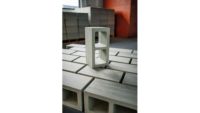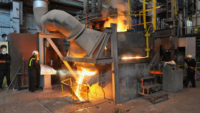Several months into a testing program for autonomous electric haulers at a century-old cement quarry in Switzerland, multinational aggregates manufacturer Holcim seeks new ways to decarbonize its operations.
One approach is by deploying autonomous machines, says Fabio Carluccio, Holcim’s head of quarry decarbonization. A typical firm quarry produces 1 million metric tons of limestone per year, hauled over a 1-km to 1.5-km track during restricted shift schedules by giant dump trucks. The sites have heavy fuel consumption, with large dozers, drills and graders, along with noise and dust. “In many countries this is putting our operating licenses at very serious risk,” Carluccio says. “We have a serious problem in that we may not be able to operate like this in 10 years, or in five. We’ve already seen examples around the world where quarries are not having their operating licenses extended.”
Research firm McKinsey & Co. says cement production accounts for about 7% of global carbon emissions. Among Holcim’s materials, cement is by far the largest emitter. Carluccio says Holcim has more than 600 quarries globally. He sees electrified, autonomous or semi-autonomous machines as a way to lower emissions. Smaller vehicles are easier to electrify—a lower vehicle-to-payload ratio means smaller batteries—and may be easier to maintain. Holcim Switzerland teamed up with Volvo Autonomous Solutions last year to test commercially-available battery-electric haulers at its Gabenchopf quarry, with Swisscom mobile telecommunications managing the wireless dataflow that monitors and controls the machines.
Carluccio seeks more partnerships to tackle the problem. “We want to co-develop new concepts and technologies and adapt from other industries, piloting and deploying them before final versions are commercially released,” he says. Holcim also is exploring robotics, predictive maintenance, sensor technology and creating digital twins for quarrying, Carluccio says. “We’re looking to work with suppliers, universities, startups, telecom providers, power supply and distribution companies, system integrators and permitting entities,” he says.
Electrification is key, says Freiberg University engineering professor Martin Sobczyk, but the industry faces difficulties to get there. “Big machines are fascinating, but they also make it difficult to electrify,” he says. Sobczyk notes that since the real goal is productivity, manufacturers should consider redesigning machines and operations directly. Smaller electrified semi-autonomous vehicles could provide the same stream of raw materials as larger ones, increasing productivity and cutting emissions. “Your driver is no longer driving three hours down into the deepest part of the quarry, picking up 40 tons and driving another three hours up again,” Sobczyk says. “Rather he or she is supervising the lorries moving around from a safe distance, while they bring up the same or a higher amount of ore or lime from down there.”





Post a comment to this article
Report Abusive Comment